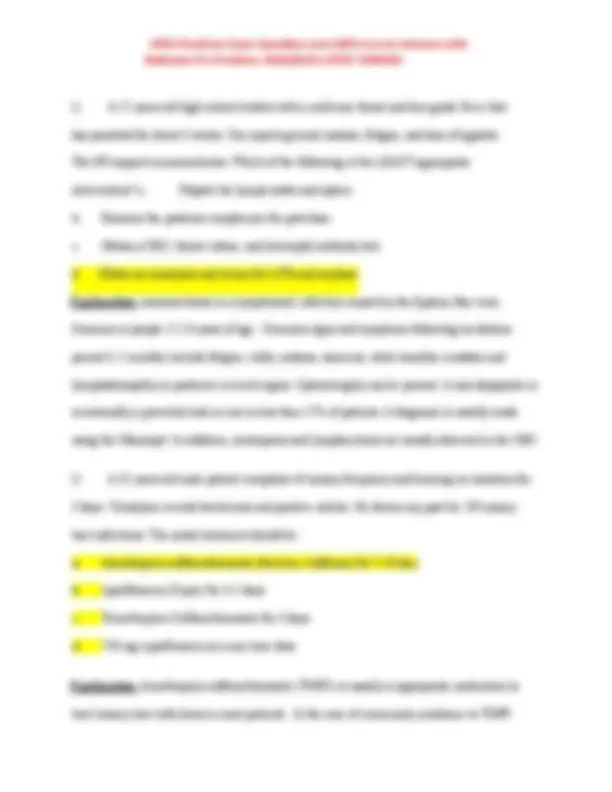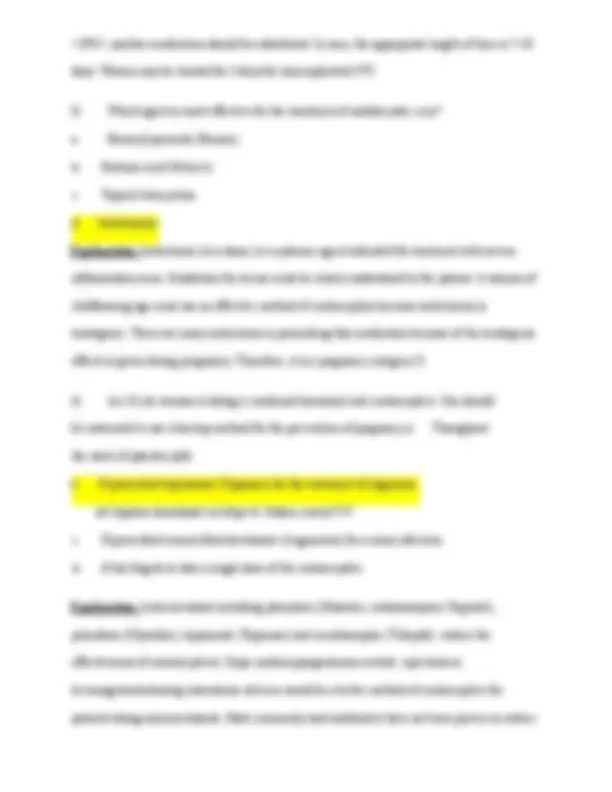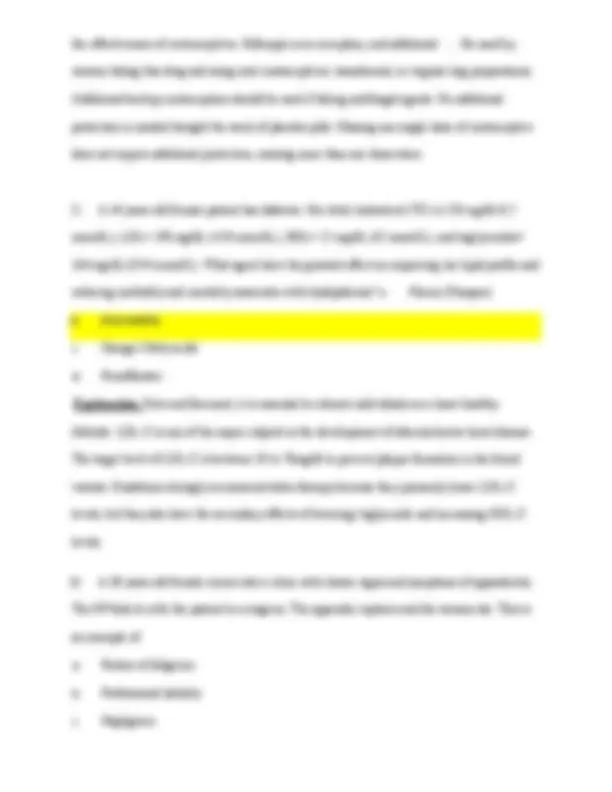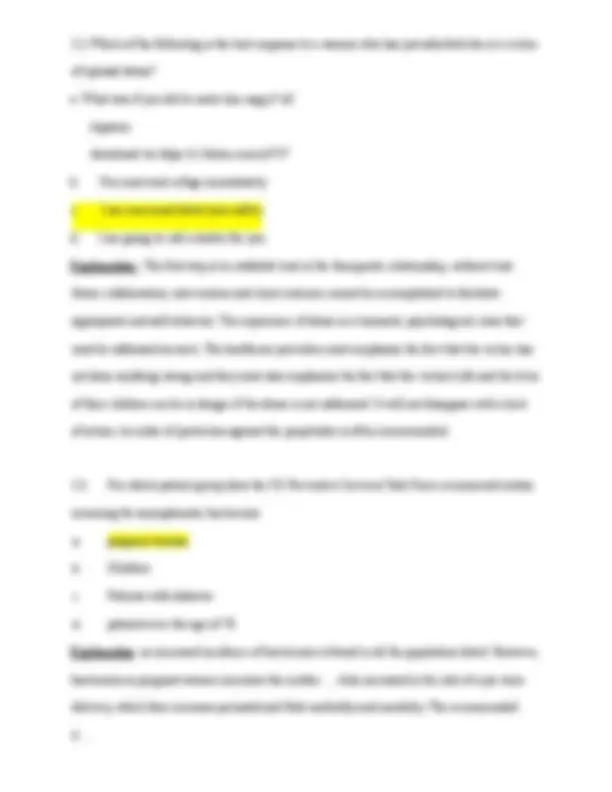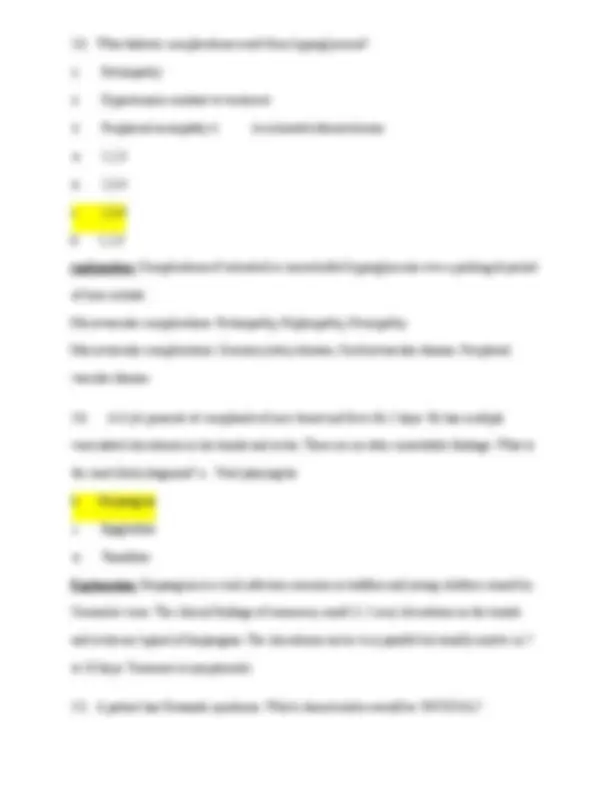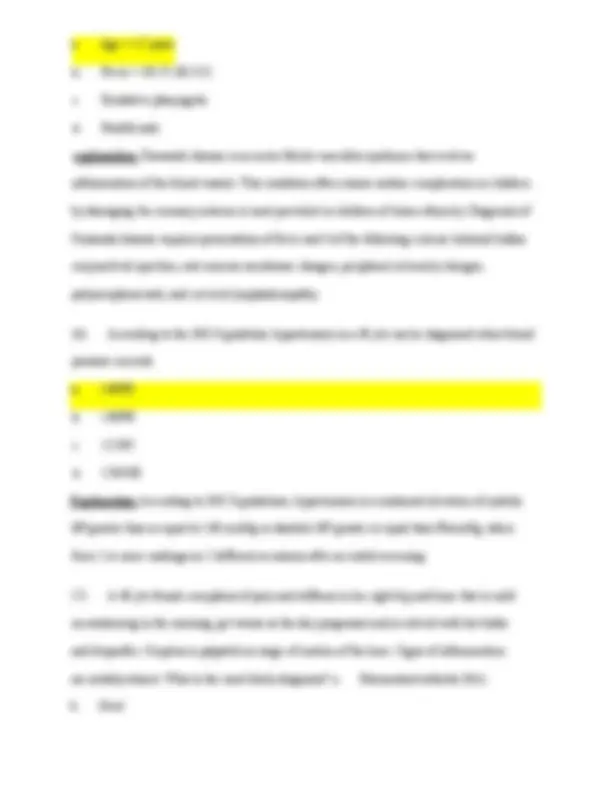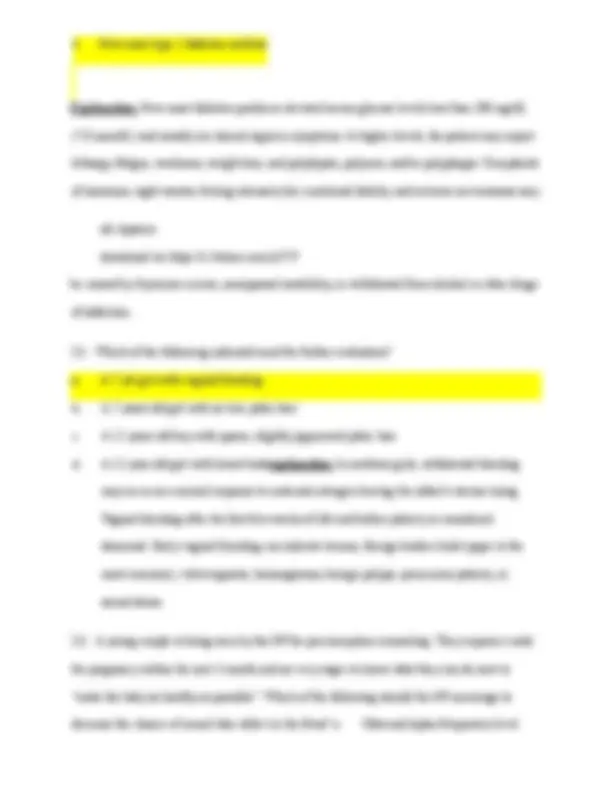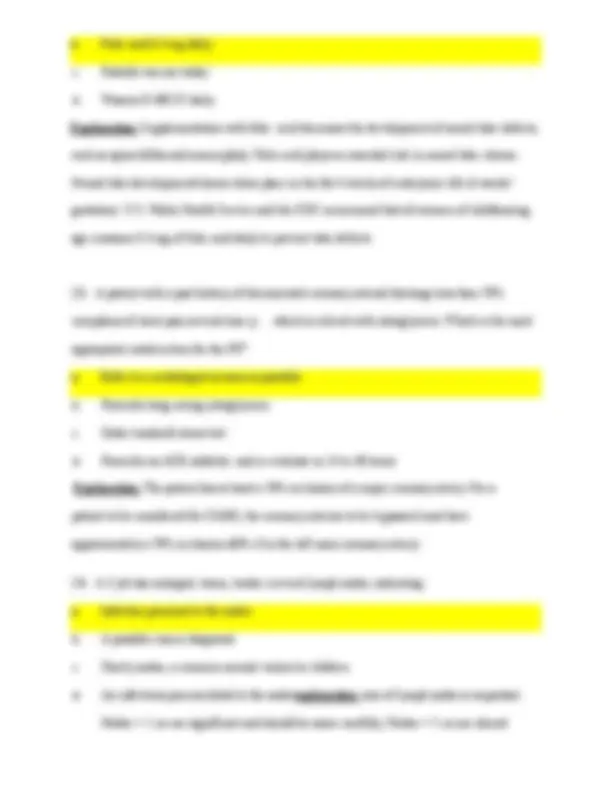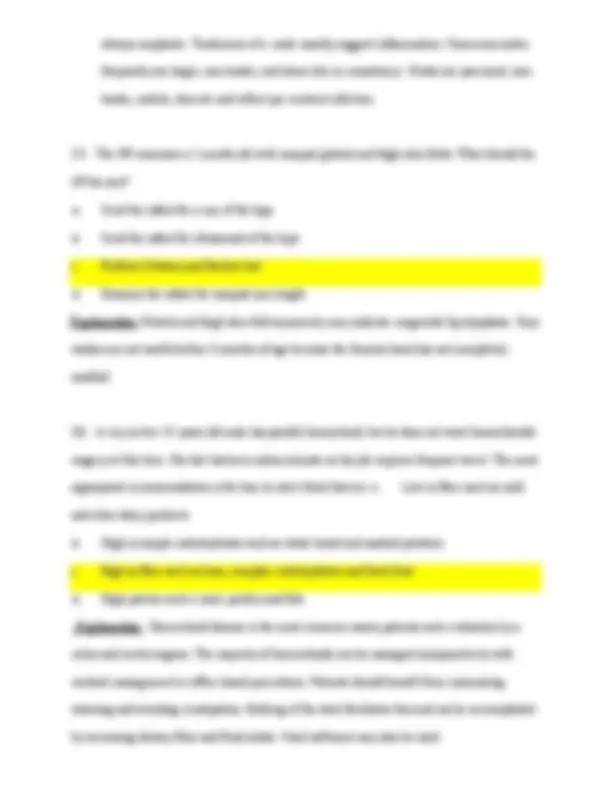Download APEA Predictor Exam Questions and 100% Correct Answers with Rationale Pre-Predictor 202420 and more Exams Nursing in PDF only on Docsity!
APEA Predictor Exam Questions and 100%
Correct Answers with Rationale Pre-
Predictor 202 42025 Latest Version
20%^, another medication should be substituted. In men, the appropriate length of time is 7- 10 days. Women may be treated for 3 days for uncomplicated UTI
- Which agent is most effective for the treatment of nodulocystic acne? a. Benzoyl peroxide (Benzac) b. Retinoic acid (Retin A) c. Topical tetracycline d. Isotretinoin) Explanation: Isotretinoin (Accutane) is a systemic agent indicated for treatment with severe inflammatory acne. Guidelines for its use must be clearly understood by the patient. A woman of childbearing age must use an effective method of contraception because isotretinoin is teratogenic. There are many restrictions in prescribing this medication because of the teratogenic effects is given during pregnancy. Therefore, it is a pregnancy category X.
- An 18 y/o woman is taking a combined hormonal oral contraceptive. She should be instructed to use a backup method for the prevention of pregnancy a. Throughout the week of placebo pills b. If prescribed topiramate (Topamax) for the treatment of migraines. all chpaters download via https://r.24zhen.com/yt75Y c. If prescribed amoxicillin/clavulanate (Augmentin) for a sinus infection d. if she forgets to take a single dose of the contraceptive Explanation: Anticonvulsant including phenytoin (Dilantin), carbamazepine (Tegretol), primidone (Mysoline), topiramate (Topamax) and oxcarbazepine (Trileptal) reduce the effectiveness of contraceptives. Depo-medroxyprogesterone acetate injections or levonorgestrelreleasing intrauterine devices would be a better method of contraceptive for patients taking anticonvulsants. Most commonly used antibiotics have not been proven to reduce
the effectiveness of contraceptives. Rifampin is an exception, and additional …. Be used by women taking this drug and using oral contraceptives, transdermal, or vaginal ring preparations. Additional backup contraception should be used if taking antifungal agents. No additional protection is needed thought the week of placebo pills. Missing one single dose of contraceptive does not require additional protection, missing more than one doses does.
- A 44 years old female patient has diabetes. Her total cholesterol (TC) is 250 mg/dl (6. mmol/L), LDL= 190 mg/dL (4.94 mmol/L), HDL= 25 mg/dL (65 mmol/L), and triglycerides= 344 mg/dL (8.94 mmol/L). What agent have the greatest effect on improving her lipid profile and reducing morbidity and mortality associates with dyslipidemia? a. Niacin (Niaspan) b. Atorvastatin c. Omega 3 fatty acids d. Fenofibrates Explanation: First and foremost, it is essential to educate individuals on a heart-healthy lifestyle. LDL-C is one of the major culprits in the development of atherosclerotic heart disease. The target level of LDL-C is between 50 to 70mg/dl to prevent plaque formation in the blood vessels. Guidelines strongly recommend statin therapy because they primarily lower LDL-C levels, but they also have the secondary effects of lowering triglyceride and increasing HDL-C levels.
- A 30 years old female comes into a clinic with classic signs and symptoms of appendicitis. The NP fails to refer the patient to a surgeon. The appendix ruptures and the woman die. This is an example of a. Failure of diligence b. Professional liability c. Negligence
containing tar and salicylic acid may be used. Topical steroids, such as betamethasone, may also be ordered.
- Antidepressant discontinuation syndrome is less likely if the patient a. Is male b. Is less than 35 y/o c. Has taken an SSRI with a short half life d. Gradually tapers SSRI use Explanation: Antidepressant discontinuation syndrome is most often seen in the primary care office in association with SSRI discontinuation, because SSRIs are the most commonly prescribed class of antidepressant medications. Interruption of treatment with an anti-depressant medication is sometimes associated with an antidepressant discontinuation syndrome; in early reports it was referred to as a “withdrawal reaction. Symptoms of antidepressant discontinuation syndrome can include flu-like symptoms, insomnia, nausea, imbalance, sensory disturbances, and hyperarousal. Tapering is recommended by experts.
- Patient with benign prostatic hyperplasia (BPH) should be taught to avoid which one of the following drug classes? a. Alpha adrenergic antagonist b. Anti-androgen agents c. Tricyclic antidepressant (TCA) d. Sulfonamides Explanation: tricyclic antidepressant should not be used by men with benign prostatic hyperplasia because of the increased risk of urinary retention secondary to the anticholigergic effects of TCAs.
- Which of the following is the best response to a woman who has just admitted she is a victim of spousal abuse? a. What was if you did to make him angry? all chpaters download via https://r.24zhen.com/yt75Y b. You must seek refuge immediately c. I am concerned about your safety d. I am going to call a shelter for you Explanation: The first step is to establish trust in the therapeutic relationship. without trust future collaboration, intervention and client outcome cannot be accomplished to facilitate appropriate and safe behavior. The experience of abuse is a traumatic psychological crisis that must be addressed as such. The healthcare providers must emphasize the fact that the victim has not done anything wrong and they must also emphasize the fact that the victim's life and the lives of their children can be in danger if the abuse is not addressed. It will not disappear with a lack of action. An order of protection against the perpetrator is often recommended.
- For which patient group does the US Preventive Services Task Force recommend routine screening for asymptomatic bacteriuria a. pregnant woman b. Children c. Patients with diabetes d. patients over the age of 70 Explanation : an increased incidence of bacteriuria is found in all the population listed. However, bacteriuria in pregnant women increases the mother…..Also increased is the risk of a pre-term delivery, which then increases perinatal and fetal morbidity and mortality. The recommended it….
a. Age > 15 years b. Fever > 101 F (38.3 C) c. Exudative pharyngitis d. Painful rash explanation: Kawasaki disease is an acute febrile vasculitis syndrome that evolves inflammation of the blood vessels. This condition often causes cardiac complication in children by damaging the coronary arteries is most prevalent in children of Asian ethnicity. Diagnosis of Kawasaki disease requires presentation of fever and 4 of the following criteria: bilateral bulbar conjunctival injection, oral mucous membrane changes, peripheral extremity changes, polymorphous rash, and cervical lymphadenopathy.
- According to the JNC 8 guideline hypertension in a 40 y/o can be diagnosed when blood pressure exceeds a. 140/ b. 130/ c. 125/ d. 150/ Explanation: According to JNC 8 guidelines, hypertension is a sustained elevation of systolic BP greater than or equal to 140 mmHg or diastolic BP greater or equal than 90mmHg, taken from 2 or more readings on 2 different occasions after an initial screening.
- A 48 y/o female complains of pain and stiffness in her right hip and knee that is mild on awakening in the morning, get worse as the day progresses and is relived with hot baths and ibuprofen. Crepitus is palpated on range of motion of the knee. Signs of inflammation are notably absent. What is the most likely diagnosis? a. Rheumatoid arthritis (RA) b. Gout
c. Osteoarthritis (OA) d. Osteoporosis Explanation: Rheumatoid arthritis is characterized by several joint deformities, usually bilaterally symmetrical. RA is characterized by inflammatory processes, while OA is not. RA and OA are chronic conditions. Gout is characterized by acute exacerbations related to a defect in purine metabolism, increased uric acid production, or decreased uric acid excretion.
- A 7-year old female patient presents with severe injuries that are inconsistent with the explanation given for them. The nurse practitioner questions the mother about abuse. She admits that her husband, the child’s father, beat the child. How should the nurse practitioner proceed? a. Inform the mother that the abuse must be reported to child protection authorities. b. Counsel the mother that if it happens again it will be reported to child protection service. c. Ask the child what she did to cause the punishment d. Refer the family to the National Domestic Violence hotline. Explanation: An awareness of all the unique presentations of child abuse, subjective or objective, physical, sexual, or neglect, is essential for NPs. Objective findings, such as broken bones, burns, and bruises, may be as a result of an intentional injury from physical abuse or from an unintentional injury as a result of neglect. Both must be considered. Repeated visits to the emergency department, frequent or suspicious injuries, or bilateral or multiple healing fractures are often indicators of physical abuse. Once the diagnosis of child abuse has been made, the primary role of the NP is to ensure the child is safe. If the NP suspect that a child is undergoing abuse, it’s critical to report it—and to continue reporting each separate incidence if it continues to recur.
- A 1-month-old presents with reported recurrent diarrhea, screaming, and drawing up of the legs followed by periods of lethargy. On physical examination, a “sausage-like” mass in the
d. New onset type 2 diabetes mellitus Explanation: New onset diabetes produces elevated serum glucose levels less than 200 mg/dL (7.0 mmol/L) and usually no clinical signs or symptoms. At higher levels, the patient may report lethargy, fatigue, weakness, weight loss, and polydipsia, polyuria, and/or polyphagia. Complaints of insomnia, night sweats, feeling intensely hot, emotional lability, and extreme nervousness may all chpaters download via https://r.24zhen.com/yt75Y be caused by thyroxine excess, menopausal instability, or withdrawal from alcohol or other drugs of addiction.
- Which of the following indicated need for further evaluation? a. A 7 y/o girl with vaginal bleeding b. A 7 years old girl with no true pubic hair c. A 12 years old boy with sparse, slightly pigmented pubic hair d. A 12-year-old girl with breast buds explanation: In newborn girls, withdrawal bleeding may occur as a normal response to maternal estrogen leaving the infant’s uterine lining. Vaginal bleeding after the first few weeks of life and before puberty is considered abnormal. Early vaginal bleeding can indicate trauma, foreign bodies (toilet paper is the most common), vulvovaginitis, hemangiomas, benign polyps, precocious puberty, or sexual abuse.
- A young couple is being seen by the NP for preconception counseling. They express a wish for pregnancy within the next 3 month and are very eager to know what they can do now to “make the baby as healthy as possible”. Which of the following should the NP encourage to decrease the chance of neural tube defect in the fetus? a. Maternal alpha-fetoprotein level
b. Folic acid 0.4 mg daily c. Rubella vaccine today d. Vitamin E 400 IU daily Explanation: Supplementation with folic acid decreases the development of neural tube defects, such as spina bifida and anencephaly. Folic acid plays an essential role in neural tube closure. Neural tube development/closure takes place in the fist 4 weeks of embryonic life (6 weeks’ gestation). U.S. Public Health Service and the CDC recommend that all women of childbearing age consume 0.4 mg of folic acid daily to prevent tube defects.
- A patient with a past history of documented coronary arterial blockage less than 70% complains of chest pain several time p…. which is relived with nitroglycerin. Which is the most appropriate initial action for the NP? a. Refer to a cardiologist as soon as possible b. Prescribe long-acting nitroglycerin c. Order treadmill stress test d. Prescribe an ACE inhibitor and re-evaluate in 24 to 48 hours Explanation: The patient has at least a 70% occlusion of a major coronary artery. For a patient to be considered for CABG, the coronary arteries to be bypassed must have approximately a 70% occlusion (60% if in the left main coronary artery).
- A 3 y/o has enlarged, warm, tender cervical lymph nodes, indicating: a. Infection proximal to the nodes b. A possible cancer diagnosis c. Shorty nodes, a common normal variant in children d. An infectious process distal to the nodes explanation: size of lymph nodes is important. Nodes > 1 cm are significant and should be asses carefully. Nodes > 5 cm are almost
- Correct instructions to give new parent who are transporting their newborn infant is a. A rear-facing infant car seat secured in the backseat is required until the infant weight 20 lbs. b. The infant car set may be secured in the back or front seat, but must rear-facing c. The infant car seat may be front facing when the infant is 1 year old d. A rear or front-facing infant car seat must be secured in the back seat until the infant weight20 lbs. Explanation: The American Academy of Pediatrics (AAP) recommends that infants and toddlers ride in a rear-facing seat until they are 2 years old or until they have reached the maximum weight and height limits recommended by the manufacturer
- A 13 y/o pt. complains that he fell while running during football practice. Now his knee hurts and sometimes “lucks”. The NP conducts McMurrays test. Which of the following is TRUE about this test? a. An audible or palpated “click” is positive for a torn meniscus b. A various stress is applied to the flexed knee c. The straight leg is internally rotated with the patient supine and flat d. The knee is grasped with the examiner’s fingers placed laterally. Explanation: Mac Murray’s test is conducted while the patient is in the supine position. The NP places the distal hand on the foot and raises the knee slowly, keeping the foot and knee externally

